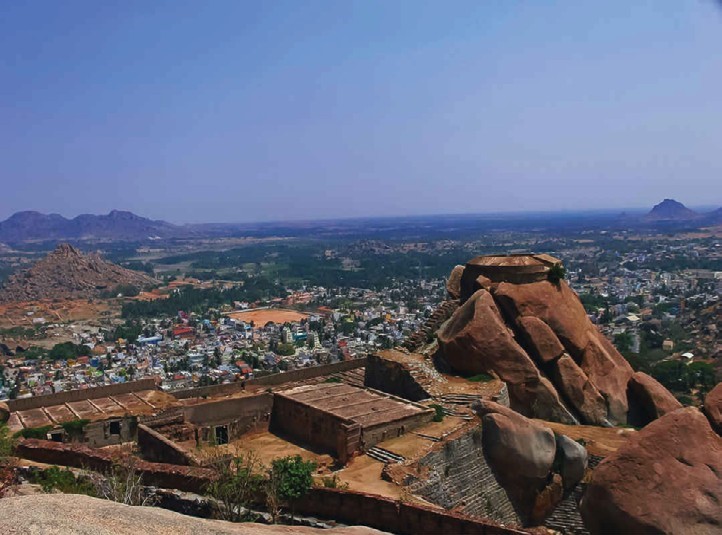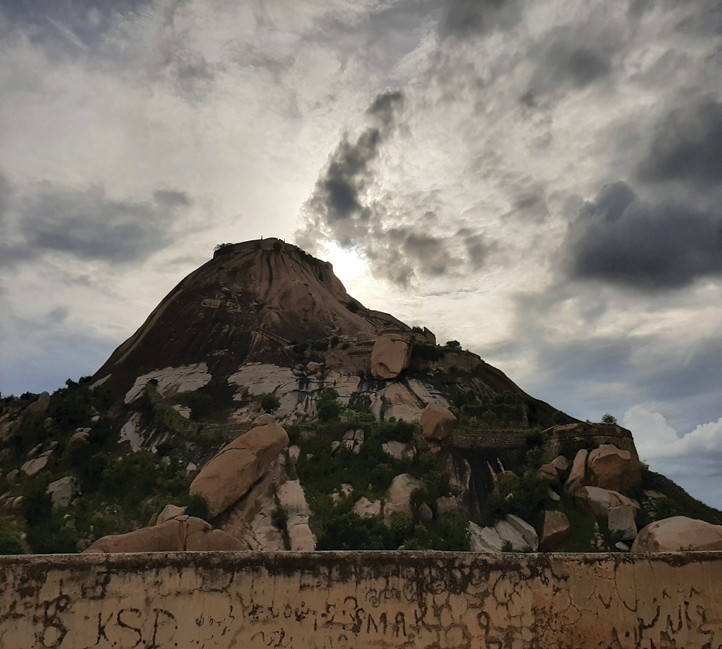 Madhugiri -This monolithic rock is 3935 feet in
Madhugiri -This monolithic rock is 3935 feet in
height and surrounded by many hill ranges
Madhugiri is one of the largest monoliths of Asia. But there is no banner or signboard in this area to proclaim this. A short blue ASI board at Madhugiri foothills is the only introduction you get to this mighty hillock. Trekking up the hill with its granite outcrops, sturdy lime stone fortifications, temples, zig-zag boulders you get a feel of its grandeur. And perhaps of its ancient past. But no brochures, guide books, audio guides or signage exists either to trek up this hill or give some kind of information on its past.
However there is plenty of literature on Madhugiri. There are also books written by court poets, folk songs and by Kannada writers like Masti Venkatesh Iyengar, Dodda Ranga Gowda on Madhugiri. There are archaeological sources like inscriptions too that talk about the dynasties gone by. Foreign travellers have commented about Madhugiri in their journals.
The hill fortress
Madhugiri is just 37 kilometres from Tumkur. This monolithic rock is 3935 feet high and sees many tourists– especially trekkers and adventure groups in season. The granite outcrop stands majestically and can be sighted from far. Madhugiri is surrounded by plenty of hill ranges- Devarayanadurga, Kortagere, Siddarabetta, and Chennarayanadurga to name a few. In fact a traveller Buchanan says about this hillock, “the view of Maddagiri hill on approaching from East is much finer than that of any hill fort I have seen.”
Perhaps it is these hill ranges that made Madhugiri, a giridurga or a hill fortress. On the east of Madhugiri there is Penugonda hill, on west there is Sira,in north there is Nidugal and in south there is Kortagere. So Madhugiri is ideal as a hill fortress. The rivers Jaya, Mangala, Kumudwathi flow here and are responsible for its lush landscape.
Many dynasties ruled here if the inscriptions discovered are anything to go by. Madhugiri occurs in various inscriptions of Gangas, Nolambas and Cholas. It comes across as a battle ground for the various battles that were fought between Gangas and Cholas and Gangas and Nolambas. Memorial stones have also been found there. During Chola period, the kings built temples like Choleshwara and constructed tanks like Cholarayanakere. Inscriptions of Hoysala dynasty especially related to King Vishnuvardhana and Ballala III also mention about Madhugiri. Many land grants were given in Madhugiri region by Hoysalas to vassal chiefs for services rendered.
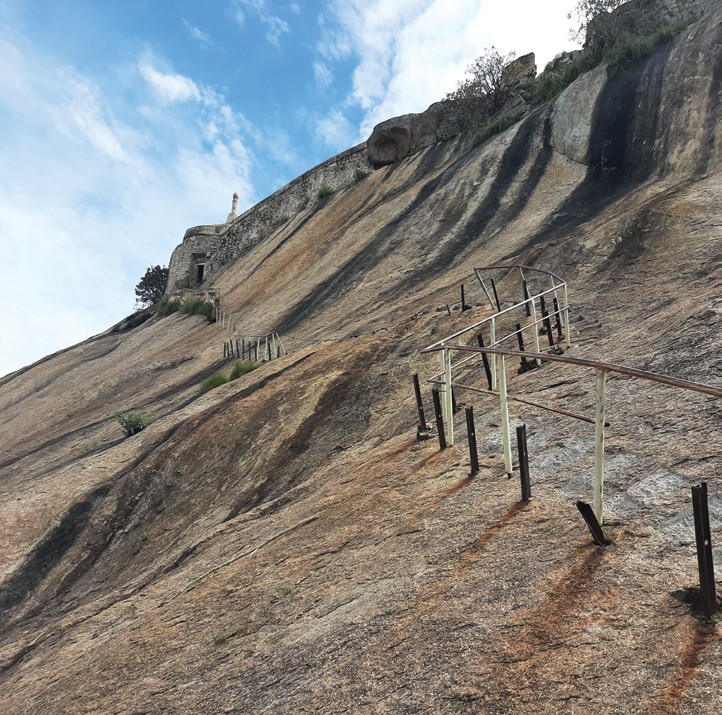 The granite outcrop stands majestically and can be sighted from far
The granite outcrop stands majestically and can be sighted from far
History of Madhugiri
South of India was dominated by the Vijayanagara Empire from 14th century onwards. The empire was founded by Sangam brothers and then ruled by various dynasties like Saluva, Tuluva and Aravidu. There were hundreds of chieftains reporting to Vijayanagara Empire from various corners of South India. Madhugiri too was one of them.
After the battle of Talikota in 1565 that dealt a death blow to Vijayanagara Empire, many regions like Gingee, Tanjore, Keladi, Madurai in the south became independent. However Madhugiri continued to remain loyal to Vijayanagara till the downfall of Aravidu dynasty.
Madhugiri was the third capital of Madhugiri chieftains. Earlier it was known as Maddagiri. During the reign of Hyder Ali and his son Tipu Sultan, it functioned as an administrative centre.
 What used to be a granary at one time
What used to be a granary at one time
Madhugiri chieftains
Madhugiri chieftains go by various names like Nada Prabhugalu, Gowdaru or Palegararu. The Midigeshi Kaifiyat gives some details about the Madhugiri chieftains. According to it, there were seven brothers who were in services of a saint named Karmayogi Sida Rameshwara. The eldest of the brothers was Veerapagowda. Pleased with their services, the saint blessed and ordered them to proceed to Vijayanagara Kingdom. This they did so. They joined the cavalry of unit of the Vijayanagaras under Sangam dynasty. When Delhi under Mallakhan attacked Vijayanagara the brothers fought with courage and won.
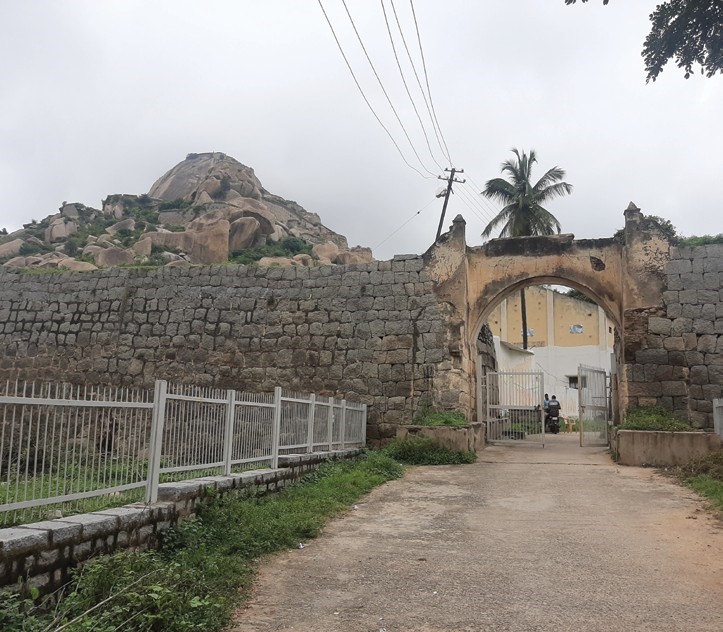 The entrance to Madhugiri fort
The entrance to Madhugiri fort
The Vijayanagara king, pleased with their valour made them feudatories of Madhugiri region. The brothers founded various settlements. The eldest Veerapagowda founded the village Nonambasagara and built a temple Nonambeshwara. The other brothers founded different settlements at Kora, Tereyuru, Gubbihosahalli, Ennegere, Cheluru and Bidare of Tumkur district.
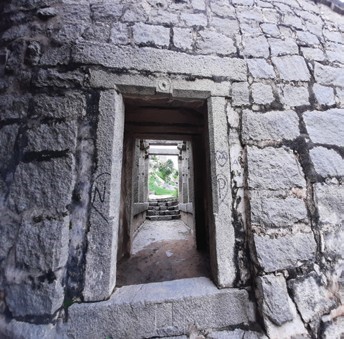 The many stone gateways that you need to pass before starting the rocky climb
The many stone gateways that you need to pass before starting the rocky climb
In 1321, the descendant of Veerapagowda, Hiriya Veerapagowda founded the capital Mumadipatna. This was the first capital. As this region was called Mahanadu, rulers henceforth began to be called as Mahanada Prabhu. The town of Mumadipatna was fortified and temples were built.
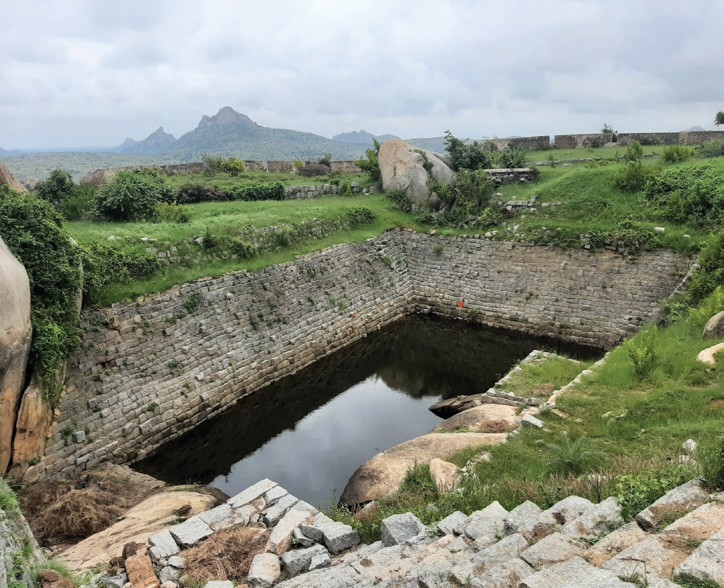 Hanumandone, a water tank in the fort premises built by one of the Madhugiri chieftans
Hanumandone, a water tank in the fort premises built by one of the Madhugiri chieftans
Dodagowda, the successor expanded the capital and constructed many temples. However the town was destroyed by the Bahmani army. It was again reconstructed during the reign of Hire Chikapagowda, the son of Dodagowda.
Hire Chikapagowda was responsible for building the second capital at Bijavara. A strange story is related to setting up of the second capital. It is said that the goddess Bijamahadevi came in his dreams urging the chieftain to construct a village. The chieftain on the orders of the goddess, rode on his horseback searching for a suitable place for his capital. In one of his rounds he saw a hare chasing dogs and recognised the place suitable for his capital. In 1526 he constructed the capital at this place and named it as Bijavara. He also constructed a fort, water body and temple.
Madhugiri chieftains or Mahanada Prabhus were loyal to Vijayanagara Kingdom throughout their reign. After the fall of Vijayanagara kingdom, the Aravidu dynasty revived the kingdom at Penugonda. The Madhugiri chieftains were loyal to Aravidu kings, helping them in their battles.
Another worthy successor of Madhugiri Nadaprabhus was Immadi Chikabhupala who built Siddapura village, fort and the Gopalkrishna temple in Madhugiri region. In 1646, the capital was changed again to Maddagiri. Tanks like Hanumandone, a granary and ammunition dump were also was built for Maddagiri.
Mummadi Chikapagowda was the younger son of Chikabhupala. He built the temples of Malleshwara and Venkatramana in Madhugiri. He had three sons. One of his son Kala Chikapagowda ruled Midigesi. Kala Chikapagowda’s two sons Ramapagowda and Timegowda were not on good terms with Mysore king Chikadevaraya Wodeyar. So the Mysore king sent his dalvayi, Devaraja to deal with the brothers. This incident happened in 1678. A seize was laid, the brothers were defeated and put in prison and Madhugiri went into the hands of the Mysore king. The brothers were however later released and were given the estate Midigeshi to rule.
Madhugiri was important for the Mysore king Chikadevaraya. It served as the northern frontier for Mysore kingdom. Sira located close by was the foothold of Nawab and so it was important for the Mysore king to strengthen the defences of Madhugiri. In 1690 Chikadevaraya Wodeyar chose to stay with his wife in Madhugiri for some time. He expanded the temples of Malleshwara and Venkatramana and also built a granary. He also built an agrahara-settlement for Brahmins.
When Hyder Ali became the de-facto ruler of Mysore, he too focussed on Madhugiri. He expanded the fortification, contributing arches, watchtowers and granaries to the place. In the 1763 battle with Bidnur he sent the queen of Bidnur to Madhugiri, as a prisoner. She was in prison until 1767 when the
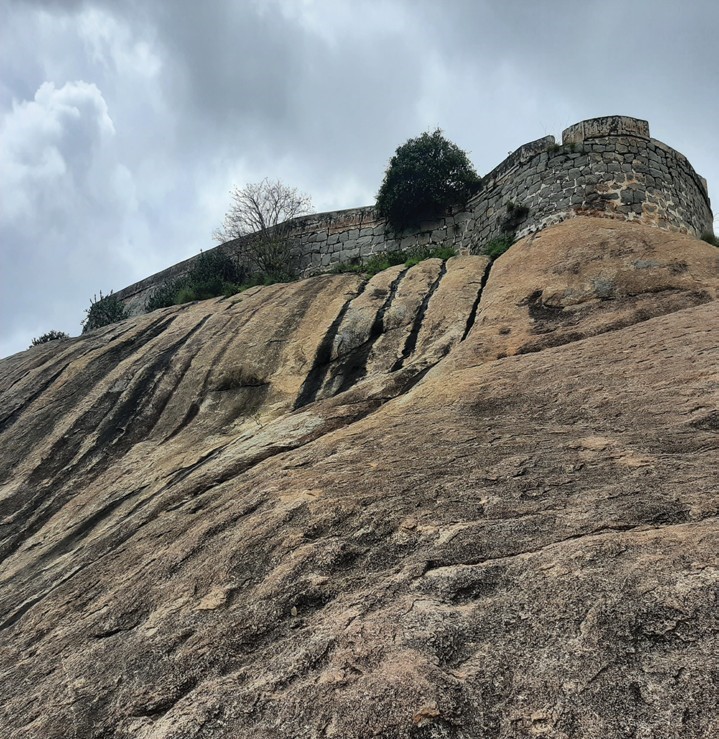 The climb to the fort is steep and challenging
The climb to the fort is steep and challenging
Madhugiri fort was captured by Marathas. Maratha chief under Madhava Rao ruled this place for seven years after which it came into the hands of Tipu Sultan, son of Hyder Ali and the sultan of Mysore. Tipu Sultan renamed the place as Fattehabad — the city of victory and made it the headquarters of the surrounding district.
In 1792 with the third Anglo-Mysore war the rule of Mysore on Madhugiri ended. Tipu Sultan who was the sultan of Mysore tried to get back his kingdom from the British but was not successful.
After Tipu’s death and the coming of British, Madhugiri got included as part of the new Mysore territory. In 1927 Maddagiri was renamed as Madhugiri by Masti Venkatesha Iyengar who was the deputy commissioner of Tumkur district. Today Madhugiri is the taluk headquarters of Tumkur district.
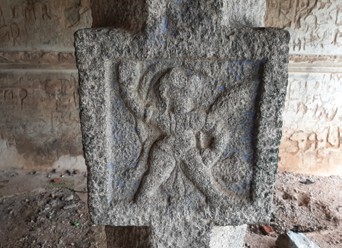 Motifs on the fortified walls
Motifs on the fortified walls
Madhugiri trek trail
Madhugiri is strongly fortified and makes for a challenging trek. It has several gates (called baigilu in local language) that lead you to the top like Antarada bagilu, Diddi bagilu and Mysore bagilu. You also come across several springs such as Bhima done, Chandra done, Navilu done etc., in Madhugiri.
Madhugiri trek looks easy. But it isn’t. The ascent is gradual, steep in sections, stone steps to help you here and there, railings in few places and in few sections you are on your own. The trek makes you walk, hike, crawl, leap and scramble. You use your brain and your body to trek this gigantic hill. The trek challenges you, brings your fears to the forefront.
There are many sections before you reach the top. The first 30 minutes is easy. At the foothills there is a temple of Lord Vishnu. You start the trek from here. The vistas that greets you here are boulders, ramparts of hill fort, bastions and watch towers. Grassy mounds, native trees and bushes dot the landscape. A stone tiled pathway takes you to the first passageway.
A couple of steps help you ascend further up. From here there are stone stairs to take you to towards the first rampart sections of Madhugri fort. Here and there you will see few secular buildings and lime mortar walls. The structure is beautiful but is sadly defaced with crude writings.
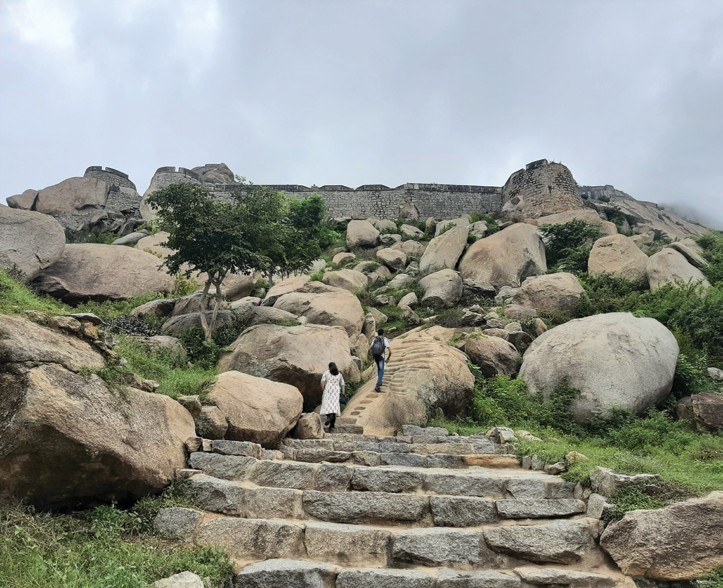 Steps carved on rocks and railings at a few places are your only guide on the trek
Steps carved on rocks and railings at a few places are your only guide on the trek
Further upwards you reach the rampart sections of the fort. The doorway here is simple. Pass through this and you next reach a doorway- plain stone structure, roofless, supported by stone pillars with a small carving of lotus at its lintel. The vista here is different. It is a small section, grassy in places and dotted with a few empty shrines.
The huge fortification of next rampart greets you and you pass the second entrance gateway. You can pause for a few seconds here, sip a few drops of water and rest. The roofed structure is a welcome break from the hot sun.
As you make your way up, huffing and puffing, you encounter monkeys easily leaping through the fortified walls as if it were child’s play. For a second you might even wish to trade places.
Next visible landmark is a pond. A few stone steps take you to the bottom of pond. There are fine imprints of Hanuman, Ganesh on the walls of the pond. Nearby there is a stone bastion as well. You can trek up this bastion.
Hiking upwards from the pond there is a grassy section next. It has a small shrine of Hanuman on its left. Spend a few minutes here if you wish. You next sight is a doorway; cross that and then the next section begins.
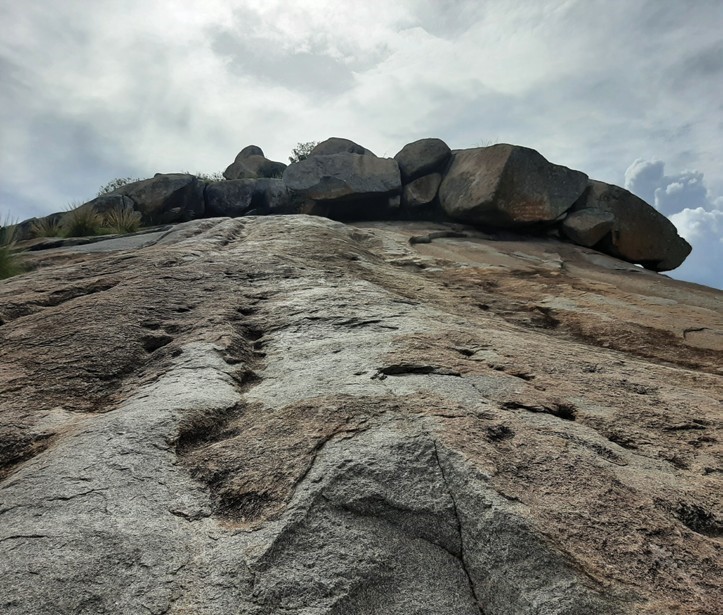 A trek that makes you walk, hike, crawl, leap and scramble
A trek that makes you walk, hike, crawl, leap and scramble
Steps carved on rocks and railings are your only guide for the next two hours. Most of this part has railings, but at a few places you just have the bare face of the rocky hill to climb. However wedges on the rocks prop you up. There are faint arrow marks in white to help you. Look out for that. It is easy to get confused as there are divergent paths to take you atop. Huge boulders of rocks, open vistas of nearby hills, downtown village are recurring scenery here.
The tricky part in this section is a steep trail that has no ropes or railings. However there are steps etched on the boulders. Place one step at a time, maintain your balance and go ahead. You could also perch on the rock and scramble up.
After this tricky part it is a comparatively easy climb for the next 20 minutes. Look out for the fortifications here with its Mughal style motifs. There are a variety of mountain flowers in various hues not to mention the colourful lantana shrubs. The panoramic view here gives you a glimpse of the open country side, the Madhugiri town and the various ghats surrounding it.
Though there are no supportive railings, the climb is not steep. Keep on the lookout for faint arrow marks that guide you on the route. After 20 minutes or so you reach the last gateway that takes you towards the fort. Here the climb is a bit steep so one has to be careful. After crossing the last gateway the final section is just 10 minutes climb that takes you to the Madhugiri fort.
At the top of the hill there are the ruins of Gopalakrishna temple, granaries of finger millet or ragi and also a treasury. There are also storage structures called kanajas to store ghee and oil.
Madhugiri excursions
There are a couple of popular spots near Madhugiri that can also be included in your itinerary.
There are temples of Dandina Maramma – the village deity and Dravidian styled temples of Venkatramana and Malleshwara Swamy. The temples were built during the time period of Chikappa Gowda. There is also an 800-year-old Mallinatha basadi- a shrine for the 19th Jain Tirthankara in Madhugiri. Other excursions to plan are:
Devarayanadurga
It is known by various names including Karigiri and Jadakanadurga. It got the name Devarayanadurga after the Mysore King Chikadevaraja Wodeyar captured it in 1696 from the chief Jadaka. The hillock boasts of temples of Narasimha , scared ponds like pada-teertha, cave temple of Rama. Namada Chilume, a popular natural spring is located closeby.
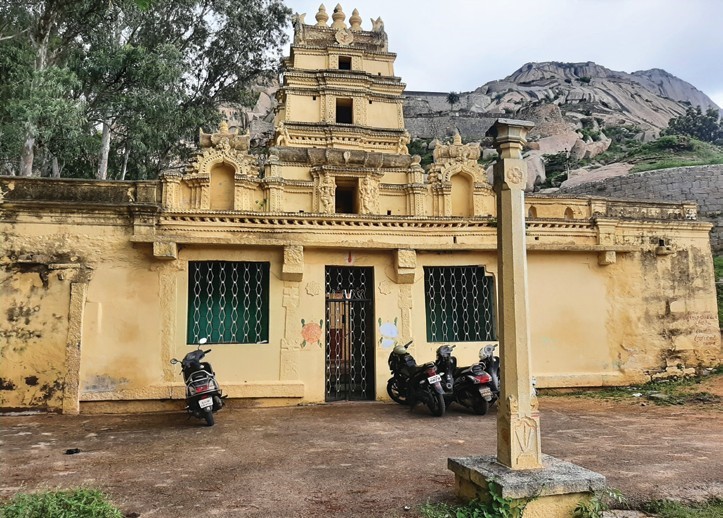 One of the many temples at Madhugiri
One of the many temples at Madhugiri
Chennarayanadurga
This hillock at an altitude of 3734 feet has a 17th century fort built by chief of Madhugiri Channapa Gauda. The fort changed hands several times under Marathas and Mysore rulers. Apart from the fort, there are 18th century inscriptions, cave temple of saint Murariswami and also samadhis/tombs of his disciples.
Blackbuck reserve
Jayamangali Blackbuck Reserve is a reserved forest, 22 kilometres from Madhugiri. It is the haunt of Black Bucks and is a must visit for any wild life lover. You can spot a variety of birds and deer as well.
Siddara Betta and Goravanhalli Mahalakshmi temple are other popular excursions.
Usha Hariprasad
Usha Hariprasad is a freelancer who is fond of travelling, discovering new places and writing about travel related destinations around Bangalore at Citizen Matters. Currently, she works in a trekking organisation.

